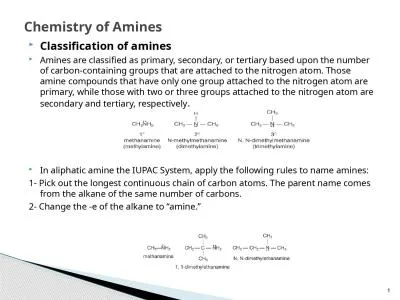

Amines are classified as primary secondary or tertiary based upon the number of carboncontaining groups that are attached to the nitrogen atom Those amine compounds that have only one group attached to the nitrogen atom are primary while those with two or three groups attached to the nitrogen a ID: 914263
Download Presentation The PPT/PDF document "Classification of amines" is the property of its rightful owner. Permission is granted to download and print the materials on this web site for personal, non-commercial use only, and to display it on your personal computer provided you do not modify the materials and that you retain all copyright notices contained in the materials. By downloading content from our website, you accept the terms of this agreement.
Slide1
Classification of aminesAmines are classified as primary, secondary, or tertiary based upon the number of carbon-containing groups that are attached to the nitrogen atom. Those amine compounds that have only one group attached to the nitrogen atom are primary, while those with two or three groups attached to the nitrogen atom are secondary and tertiary, respectively.In aliphatic amine the IUPAC System, apply the following rules to name amines:1- Pick out the longest continuous chain of carbon atoms. The parent name comes from the alkane of the same number of carbons.2- Change the -e of the alkane to “amine.”
Chemistry of Amines
1
Slide2Salts of amines named by replacing - amine by ammonium (or aniline by anilinium) and adding the name of the anion ( chloride, nitrate, sulfate …. etc)
2
Slide3Boiling Point and Water SolubilityIt is instructive to compare the boiling points and water solubility of amines with those of corresponding alcohols and ethers. The dominant factor here is hydrogen bonding, and the first table below documents the powerful intermolecular attraction that results from -O-H---O- hydrogen bonding in alcohols (light blue columns). Corresponding -N-H---N- hydrogen bonding is weaker, as the lower boiling points of similarly sized amines (light green columns) demonstrate. Alkanes provide reference compounds in which hydrogen bonding is not possible.Physical Properties of Amines
Compound
CH
3
CH
3
CH
3
OH
CH
3
NH
2
CH
3
CH2CH3CH3CH2OHCH3CH2NH2Mol.Wt.303231444645BoilingPoint ºC-88.6º65º-6.0º-42º78.5º16.6º
3
The second table illustrates differences associated with isomeric 1º, 2º & 3º-amines. Since 1º-amines have two hydrogens available for hydrogen bonding, we expect them to have higher boiling points than isomeric 2º-amines, which in turn should boil higher than isomeric 3º-amines (no hydrogen bonding).
Compound
CH
3
(CH
2
)
2
NH
2
CH
3
CH
2
NHCH
3
(
CH
3
)
3
N
Mol.Wt.
59
59
59
Boiling
Point ºC
48º
37º
3º
Slide41. Reduction of nitro compounds a. Catalytic hydrogenation using hydrogen b. Chemical reduction by a metal and acidExample:Preparation of amine
4
Slide52- Reaction of halides with ammonia or amineExample:Preparation of amine
5
Slide63. Reductive amination many aldehyde and ketone are converted into amines in presence of ammonia or amine and catalyst Example:
6
Slide74. Reduction of nitrilesThe special of increasing the length of carbon chain by one carbon atomExample:
7
Slide85. Hofmann degradation of amideDecreasing the length of carbon chaine by one carbon atom.
8
Slide9Summary 9